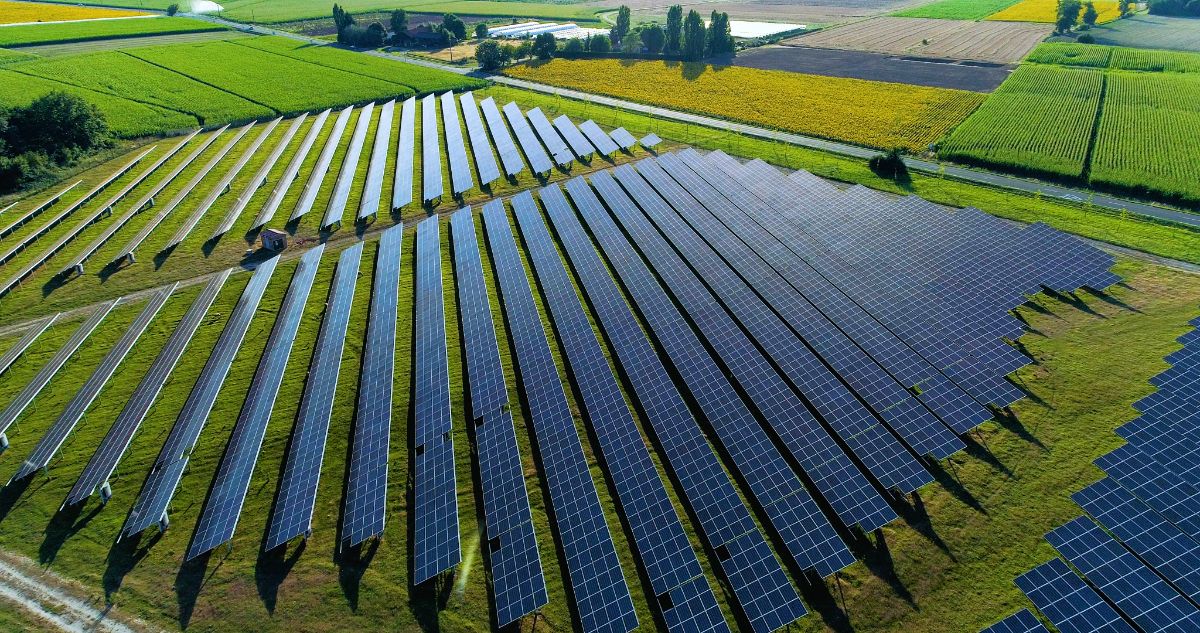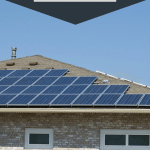Active and Passive

Solar power is just one aspect of the growing eco-friendly, environmentally-conscious, green building ethos. There are many ways to incorporate green building into your log home construction, beginning with clever log cabin home design and site preparation.
There are two kinds of solar energy: passive and active.
Passive Solar Energy
Passive solar refers to things like:
- Siting your cabin correctly on the lot to take advantage of solar warming in the winter and to avoid the sun’s heat in the summer.
- Utilizing heavy stone, concrete or wood elements inside the house in the path of the sun to absorb the heat and hold it, like a heat bank.
- Using long roof overhangs to block hit summer sun but allow in the winter sun when it’s lower on the horizon.
- Using light colored cabin roofing in the south to help reflect the summer sun, and installing a reflective barrier to block the radiant heat from the sun.
- Building with logs – a natural heat absorber with “thermal mass”.
- Using energy efficient cabin windows (pick from this chart from the Efficient Windows Collaborative) with a low U-value (U-value is the inverse of R-value, so a low U-value means a high R-value) and a high SHGC (Solar Heat Gain Coefficient).
- Adding porches to shade sunny sides of the house and reduce summer heat gain.
Active Solar Power
Active solar refers to using pumps, motors and controls to move sun-heated water or using photovoltaic (PV) cell solar panels to generate electricity.
Solar Power Using Sun-Heated Water
- Hailstone Resistance: up to φmm (1"), Max Operating Pressure: 87psi, Max Flow Rate: 5.25 gpm
- 14mm TU1 Copper Heat Pipes, Manifold insulation: 45mm 93 Kg/m^3 Rockwool, Rated Best Heat Retention
- φ58mm x 1800mm Three-Target Cu/SS-ALN(H)/SS-ALN(L)/ALN Vacuum Tubes, High Boron Silicon 3.3 Glass
- Sun Absorption Efficiency: 93-96%, Vacuum Rating: Less than 5.0 x 10^3 Pa, Lifespan:70% @ 15 Years
- OG-100 SRCC Certificate Number: 10001880, Eligible for 30% Federal Tax Rebate, Winter Resistant
Solar-heated water is one of the cheapest and easiest ways to use active solar power. The initial installation involves placing several panels on the roof that are oriented towards the sun. These have fluid in them that is heated up from the sun and cycles to a holding tank where the hot fluid transfers it heat to water.
These solar water heater panels are lightweight and easy to handle, and can be connected together to create the capacity needed.
This hot water can then be used to heat the house by circulating through PEX tubing under the floor or used directly as domestic hot water.
- Reliable – resistant to cracks, uninterrupted water flow, maintenance free, long life expectancy
- Performance – robust delivery of hot and cold water distribution system
- Flexible - ability to bend pipe making it easy to work with the bend radius of 5 feet
- Markings - PEX tubing markings unique feature imprints common standards and ratings making it easy to understand tubing properties
- PEX Type: PEX B / Color: 1 x Red + 1 x Blue / PEX Tubing Size: 1/2 Inch / Coiled: Yes / Total Length: 2 x 500 Feet / Outside Diameter: 0.625 Inch / Inside Diameter: 0.475 Inch / Pressure Ratings: 80psi @ 200F, 100psi @ 180F, 160psi @ 73F
What happens in the summer when I don’t need all that hot water?
Solar water heaters utilize a by-pass or an energy dump to dissipate the heat generated. Sometimes a solar water heater will simply be shut down so no water gets heated when you don’t want it.
What about reverse-cooling at night?
The simplest design for solar water heaters uses a drain-back system where the fluid in the panel drains back automatically when the temperature reaches a certain point. This keeps the fluid from circulating and drawing away the heat from your water tank.
Do I have to worry about freezing in the winter?
Fluids used in the solar water heater have additives to keep them from freezing, generally ethylene glycol (similar to what’s used for winterizing an RV) – not the poisonous propylene glycol used in automotive anti-freeze. In warm southern climates you may be able to use straight water with no fear of freezing.
Using thermostats, controls and quiet DC pumps, solar water heaters automatically heat your water and your house with free energy from the sun.
The relatively high initial cost can be justified by calculating the pay-back period – the time it takes you to recoup the costs of installing the system versus the amount of money you would pay normally for heat and hot water over the same time frame.
Solar Power Using PV Panels
- 【New Design】Face Lift for 14% reduction in the panel length. Higher cell efficiency by using 9 busbars technology. Compared with 5BB solar panel cells, the 9BB 166mm solar cell has a better and longer lifespan.
- 【Dimension】55.28*27.76*1.38inch. High winds (2400PA) and snow loads (5400PA).
- 【Maximum power】200W, Voltage at Pmax (Vmp):18.6V, Current at Pmax (Imp): 10.75A.
- 【Easy Installation】Diodes are pre-installed in the junction box, with a pair of pre-attached 3ft MC4 Cable.
- 【Warranty】2-year limited material and workmanship warranty. 10-year 90% output warranty. 25-year 80% output warranty.
Another active solar energy application is using photovoltaic cell or PV panels. These are the traditional solar panels you might have seen installed on a roof but the technology is changing rapidly and you may not always be able to tell when you see a solar cell panel.
Some companies are developing thin-film solar technology in sheets that can be rolled out, or implanted into roof shingles so that your entire roof becomes a solar energy collector.
Thin-film solar collectors like these are slightly less efficient so you need to have a larger array to collect the same energy as rigid solar panels.
The only real downside to PV solar panels is the high initial cost. The panels themselves are extremely reliable and last for many years with little to no upkeep.
There are government rebates and programs available to encourage the use of solar panels and you can look up your area on DSIRE: Database of State Incentives for Renewables & Efficiency.
Converting Solar DC Power to House AC Power
PV solar cells generate DC or direct current voltage. Homes use alternating current or AC voltage. You need to use an inverter to convert the voltage to usable energy. An inverter does just what the name says: it inverts the wave, changing flat DC voltage to alternating voltage.
There is a wide range of inverters, including small 300-watt inverters you may have used that plug into your car cigarette lighter and convert the DC voltage from the battery to usable AC voltage for your computer. Obviously for a house inverter you need one more substantial, like a 3000-watt modified sine wave inverter.
You also need to be careful how closely the inverter mimics standard AC voltage. Some appliances like bread machines won’t work unless the sine wave is very consistent.
Good quality inverters will transform your solar-panel generated DC power into usable house power without a hitch. You can carry on your regular lifestyle with virtually no changes.
12-volt Solar Power Kits
- Complete kit includes: (4pcs) 100 Watt Polycrystalline Solar Panel, 30-amp P30L Solar Charge Controller (w/ LCD Display ), 40 feet of UL Listed 12 AWG Solar Cable, all necessary connectors, all necessary solar mounting hardware + 1500 Watt (3000 Watt surge) VertaMax DC to AC Power Inverter, 2 pcs of 2 AWG Battery Cables for connecting the inverter to a 12V battery + 4pcs BattaMax 100Ah AGM (Maintenance Free) Deep Cycle Batteries with 2/0 AWG Interconnect Battery Cable.
- Bundle and save! Purchase all the components together and save time and money!
- Solar charging will provide on average 1600 Watt Hours (Wh) or 135 Amp hours of charge per day (depends on sunlight availability)
- Perfect kit for having an off-grid 12 volt battery system. 1500 Watt VertaMax Inverter provides plenty of AC power to run your household appliances and the battery bank will supply plenty of energy for moderate use.
- Designed for RVs, cabins, homes, boats, back-up and remote power use
If you're looking for a simple solution for supplying alternative energy for you cabin needs, you can buy complete solar power system kits that have everything you need, all designed to work together.
This is easier than buying your parts piecemeal and assures you that everything will work well together for your off-grid cabin.
Typically these will include:
- solar panels
- inverter
- battery bank
- solar charge controller
- wiring and connectors
- mounting hardware
Solar Power Economics

How much does it cost to set up a solar power array? 30 years ago the cost of installing solar power was over $6 per kWh (kilowatt-hour). In today’s market, state incentives and price efficiency reductions have reduced that figure to roughly $0.10/kWh, a drop of about 98%. The cost continues to drop with advances in technology.
In addition, this amount is the cost of your electricity that you have locked in for the next 30 years, while standard electricity prices will continue to increase.
According to the National Appraisal Institute (Appraisal Journal — Oct. 1999), your home's value increases $20 for every $1 reduction in annual utility bills, so it makes financial sense to make an investment in solar power to reduce your energy costs immediately as well as increase the value of your home.
Log homes already utilize a green, renewable resource by building with logs. You can increase your green credibility and reduce your carbon footprint by adding solar power to your log cabin, whether it’s utilizing passive solar using smart log cabin design tips and careful placement on the building site, or active solar using roof-top mounted water heaters and solar panels.
More Green Building Pages:
Green Building Your Log Cabin Green Building is one of the many appealing things about log homes.
Six Aspects of Green Building are Key Areas to Address Key areas to address in designing and building your home for maximum energy efficiency are these six aspects of green building.
Green Building Cabins Green Building means conserving energy and resources using a best-practices approach.
Thermal Bypass Checklist Guide The Thermal Bypass Checklist Guide addresses the best practice ways to be qualified as ENERGY STAR.
Log Home Systems – An Integrated Approach Using an integrated approach to log home systems will result in greater efficiency, lower building costs, superior performance and overall savings.






Leave a Reply